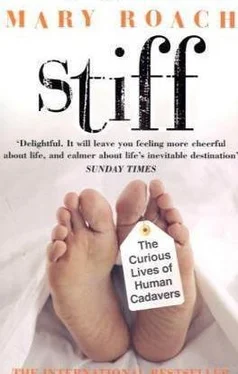Ron turns on his heels. “Great.” We ruined Rice Krispies for Ron, and now we have ruined chicken soup.
Muscles are eaten not only by bacteria, but by carnivorous beetles. I wasn’t aware that meat-eating beetles existed, but there you go.
Sometimes the skin gets eaten, sometimes not. Sometimes, depending on the weather, it dries out and mummifies, whereupon it is too tough for just about anyone’s taste. On our way out, Arpad shows us a skeleton with mummified skin, lying facedown. The skin has remained on the legs as far as the tops of the ankles. The torso, likewise, is covered, about up to the shoulder blades. The edge of the skin is curved, giving the appearance of a scooped neckline, as on a dancer’s leotard. Though naked, he seems dressed. The outfit is not as colorful or, perhaps, warm as a Harvard sweatsuit, but more fitting for the venue.
We stand for a minute, looking at the man.
There is a passage in the Buddhist Sutra on Mindfulness called the Nine Cemetery Contemplations. Apprentice monks are instructed to meditate on a series of decomposing bodies in the charnel ground, starting with a body “swollen and blue and festering,” progressing to one “being eaten by…different kinds of worms,” and moving on to a skeleton, “without flesh and blood, held together by the tendons.” The monks were told to keep meditating until they were calm and a smile appeared on their faces. I describe this to Arpad and Ron, explaining that the idea is to come to peace with the transient nature of our bodily existence, to overcome the revulsion and fear. Or something.
We all stare at the man. Arpad swats at flies.
“So,” says Ron. “Lunch?”
Outside the gate, we spend a long time scraping the bottoms of our boots on a curb. You don’t have to step on a body to carry the smells of death with you on your shoes. For reasons we have just seen, the soil around a corpse is sodden with the liquids of human decay. By analyzing the chemicals in this soil, people like Arpad can tell if a body has been moved from where it decayed. If the unique volatile fatty acids and compounds of human decay aren’t there, the body didn’t decompose there.
One of Arpad’s graduate students, Jennifer Love, has been working on an aroma scan technology for estimating time of death. Based on a technology used in the food and wine industries, the device, now being funded by the FBI, would be a sort of hand-held electronic nose that could be waved over a body and used to identify the unique odor signature that a corpse puts off at different stages of decay.
I tell them that the Ford Motor Company developed an electronic nose programmed to identify acceptable “new car smell.” Car buyers expect their purchases to smell a certain way: leathery and new, but with no vinyl off-gassy smells. The nose makes sure the cars comply. Arpad observes that the new-car-smell electronic nose probably uses a technology similar to what the electronic nose for cadavers would use.
“Just don’t get ’em confused,” deadpans Ron. He is imagining a young couple, back from a test drive, the woman turning to her husband and saying: “You know, that car smelled like a dead person.”
It is difficult to put words to the smell of decomposing human. It is dense and cloying, sweet but not flower-sweet. Halfway between rotting fruit and rotting meat. On my walk home each afternoon, I pass a fetid little produce store that gets the mix almost right, so much so that I find myself peering behind the papaya bins for an arm or a glimpse of naked feet.
Barring a visit to my neighborhood, I would direct the curious to a chemical supply company, from which one can order synthetic versions of many of these volatiles. Arpad’s lab has rows of labeled glass vials: Skatole, Indole, Putrescine, Cadaverine. The moment wherein I uncorked the putrescine in his office may well be the moment he began looking forward to my departure. Even if you’ve never been around a decaying body, you’ve smelled putrescine. Decaying fish throws off putrescine, a fact I learned from a gripping Journal of Food Science article entitled “Post-Mortem Changes in Black Skipjack Muscle During Storage in Ice.” This fits in with something Arpad told me. He said he knew a company that manufactured a putrescine detector, which doctors could use in place of swabs and cultures to diagnose vaginitis or, I suppose, a job at the skipjack cannery.
The market for synthetic putrescine and cadaverine is small, but devoted.
The handlers of “human remains dogs” use these compounds for training. [8] Purists among them insist on the real deal. I spent an afternoon in an abandoned dormitory at Moffett Air Force Base, watching one such woman, Shirley Hammond, put her canine noses through their paces. Hammond is a fixture on the base, regularly seen walking to and from her car with a pink gym bag and a plastic cooler. If you were to ask her what she’s got in there, and she chose to answer you honestly, the answer would go more or less like this: a bloody shirt, dirt from beneath a decomposed corpse, human tissue buried in a chunk of cement, a piece of cloth rubbed on cadavers, a human molar. No synthetics for Shirley’s dogs.
Human remains dogs are distinct from the dogs that search for escaped felons and the dogs that search for whole cadavers. They are trained to alert their owners when they detect the specific scents of decomposed human tissue. They can pinpoint the location of a corpse at the bottom of a lake by sniffing the water’s surface for the gases and fats that float up from the rotting remains. They can detect the lingering scent molecules of a decomposing body up to fourteen months after the killer lugged it away.
I had trouble believing this when I heard it. I no longer have trouble. The soles of my boots, despite washing and soaking in Clorox, would smell of corpse for months after my visit.
Ron drives us and our little cloud of stink to a riverside restaurant for lunch. The hostess is young and pink and clean-looking. Her plump forearms and tight-fitting skin are miracles. I imagine her smelling of talcum powder and shampoo, the light, happy smells of the living. We stand apart from the hostess and the other customers, as though we were traveling with an ill-tempered, unpredictable dog. Arpad signals to the hostess that we are three. Four, if you count The Smell.
“Would you like to sit indoors…?”
Arpad cuts her off. “Outdoors. And away from people.”
That is the story of human decay. I would wager that if the good people of the eighteenth and nineteenth centuries had known what happens to dead bodies in the sort of detail that you and I now know, dissection might not have seemed so uniquely horrific. Once you’ve seen bodies dissected, and once you’ve seen them decomposing, the former doesn’t seem so dreadful. Yes, the people of the eighteenth and nineteenth centuries were buried, but that only served to draw out the process. Even in a coffin six feet deep, the body eventually decomposes. Not all the bacteria living in a human body require oxygen; there are plenty of anaerobic bacteria up to the task.
Nowadays, of course, we have embalming. Does this mean we are spared the unsavory fate of gradual liquefaction? Has modern mortuary science created an eternity free from unpleasant mess and stains? Can the dead be aesthetically pleasing? Let’s go see!
An eye cap is a simple ten-cent piece of plastic. It is slightly larger than a contact lens, less flexible, and considerably less comfortable. The plastic is repeatedly lanced through, so that small, sharp spurs stick up from its surface. The spurs work on the same principle as those steel spikes that threaten Severe Tire Damage on behalf of rental car companies: The eyelid will come down over an eye cap, but, once closed, will not easily open back up. Eye caps were invented by a mortician to help dead people keep their eyes shut.
Читать дальше












